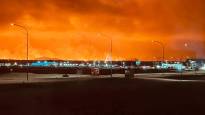The main concern is for the nearby town of Grindavík, which is a few kilometers from the eruption site.
The volcano currently erupting in Iceland is not likely to cause the same ash cloud as the eruption of Eyjafjallajökull in 2010.
With the ash cloud, air traffic in Europe was paralyzed for several days.
– This eruption has arisen in a four kilometer long crack in the earth’s crust. From there, the magma can flow into the environment. This is by no means an explosive eruption, like at Eyjafjallajökull, says Åbo Akademi’s research director and geologist Jussi Heinonen.
The eruption of a crater volcano usually begins strongly, as it does now. The eruption has already subsided within a day.
– Nothing prevents that in the near future, more magma will come from the source, and the eruption can increase. At the moment, people in Iceland are relieved that the eruption does not seem to be intensifying, says Heinonen.
Iceland is on two continental plates
A fissure volcano or fissure volcano is a type of volcano where the eruption occurs from an elongated crack in the earth’s crust instead of a central crater. Cracks are usually a few meters wide, but they can be several kilometers long.
In Iceland, rift volcanoes are often long fissures that run parallel to the rift zones in the lithospheric plates.
– Part of Iceland is on the Eurasian and part on the North American continental plate. When they separate, magma can erupt onto the earth’s surface, Heinonen says.
Iceland also has volcanoes that I like to have a more traditional look, such as Katla and Hekla, which have a central crater from which the eruption takes place. Ritual volcanoes are typical of the Reykjanes peninsula.
In fissure volcanoes, rock melt is easily flowing, liquid rock melt. Therefore, it does not cause large explosive eruptions, as in crater volcanoes, where the crater can become blocked and erupt explosively.
Residents evacuated
Lava flows from the earth’s crust at 100-200 cubic meters per second now that the eruption is still in its early stages. The eruption is estimated to last from a good week to several weeks. Heinonen says that it can even take months.
– Eruptions in this area have previously lasted even months. It may last until late spring, if not even a year.
A volcanic eruption is underway in southwest Iceland, on the Reykjanes peninsula, where preparations have been made for an eruption for several weeks.
The main concern is for the town of Grindavík, which is a few kilometers southwest of the eruption site. The 3,600 inhabitants of the fishing town have already been evacuated weeks before.
– At the moment, it seems that the lava is flowing away from the city. The situation is fine in itself. Of course, if the eruption continues for months, as some of the eruptions on this peninsula have, the situation may change.
Lava flows along the topographical contours of the earth’s crust, just like water.
– It flows where there is a low area and it can erupt. Currently it does not face the town of Grindavík.
Lava can also end up in the sea. In this case, steam and ash columns are seen, which can affect the breathing air.
– The eruption center is kilometers away from the sea, so I don’t think this is very likely.
